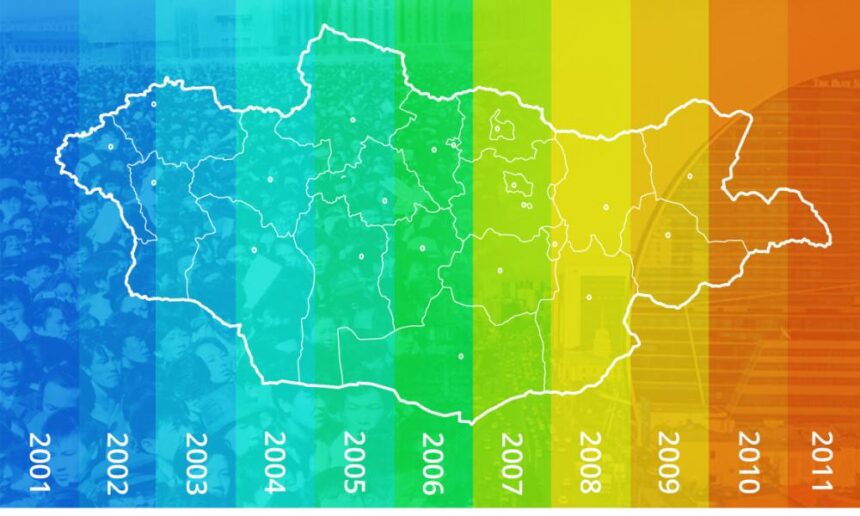Mongolia celebrates the 100th anniversary of the People’s Revolution this year. The team making a documentary about the development of Mongolia during the past century has asked me for a brief assessment of the economic development between 2001-2011.
This decade was the outcome or the logical continuation of the previous one, where the 1990 democratic revolution won and the Soviet Union, which Mongolia had followed for 70 years, disintegrated. Meanwhile our political system shifted from a single-party dominance to a multi-party parliamentary system and our economy was transitioning from public ownership to market economy.
In the 2000 parliamentary elections, 72 of the 76 seats were given to the MPRP partly because the people, who had small yet consistent income, struggled to adjust to the new conditions of the market economy and also due to the unfair privatization of public assets which were generated in the previous 70 years. During this decade, the MPRP ruled for 8 years while the DP ruled for only 2 years. The tenure of the prime ministers in office were N. Enkhbayar (4 years), M. Enkhbold (1.5 years), S. Bayar (2 years), Su. Batbold (3 years), and Elbegdorj from the DP (2004-2006).
The economy, which had barely grown in the previous decade, increased 2.2 times between 2001 and 2011, reaching $8.4 billion. The GDP per capita rose from $473 to $3,153. The economy shrunk by 1.3% in 2009 due to the Asian financial crisis but grew by 6.3% in 2010 and 17.2% in 2011, setting a world record. The basis for this growth is that Mongolia, which is rich in mineral resources, had been recognized in the world market and started to attract foreign direct investments in the mining sector following the adoption of laws that created favorable business conditions.

Source: National Statistics Office
In 2008, 9.7 million tons of coal and 127 thousand tons of copper concentrate were exported. In just three years, the figure for exported coal reached 32 million tons, and the exported copper concentrate increased to 347 thousand tons, growing 3.3 times and 2.7 times respectively. In October 2009, an investment agreement was signed to develop Oyu Tolgoi, the world’s third-largest copper deposit with 31 million tons of copper reserves. As of 2011, the mining sector accounted for 20% of GDP, 60% of the industry, 90% of the exports, and one-third of the state budget revenues. The economy started showing symptoms of the “Dutch disease” because the economy depends entirely on mining output and the state of the Chinese economy. Over this decade, the number of employees in the mining sector has increased by 11% while their salaries quintupled. The mining sector alone attracted 80% of foreign direct investments.
Many office and residential buildings were built in Ulaanbaatar, and thousands of vehicles were imported to the country. For the first time in history, Mongolians started living in fine apartments and driving decent cars on a mass scale. Nevertheless, there are more people who could not be part of it, and the social gap between the rich and the poor is becoming even more evident.
Mongolia’s telecommunications and banking sectors have gained momentum and reached the international level relatively quickly. Dozens of private universities have sprung up, and thousands of people went abroad to study and work and particularly to Korea, almost every family sent someone. Each year, an average of 30,000 people were immigrating from the countryside to Ulaanbaatar.
The capacity of public governance has not kept pace with the development and often became a hindrance. Corruption was spreading like a disease in every branch of the government. This is particularly evident for land ownership in Ulaanbaatar and around the edges of Bogd Mountain, as well as for the acquisition of mining licenses. Mongolia’s Corruption Perception Index score dropped from 3 out of 10 in 2004 to 2.7 in 2011. It can be said that the mindset of government officials and citizens revolved predominantly around taking advantage of the opportunity, seizing the moment, and not caring about the future.
The birth rate was at an all-time high in 1988 with 75 thousand. After decreasing to 49 thousand in 1998 and 45 thousand in 2005, the birth rate increased steadily, so that it reached the 1988 levels in 2012, 24 years later. This decade was marked by a physical, mental and ideological transition in the Mongolian society to adapt to new conditions. The highest number of divorced families was recorded during this period. Children were raised by grandparents or only one of their parents. Due to the decrease in the number of children, kindergarten buildings were privatized or transferred to province, city, and district administrations.

Source: National Statistics Office
According to Mongolbank’s statistics, apartment prices had an average increase of 20% between 2000-2007, 26% in 2008, a slight decline in 2009, and another year of growth in 2011 with 30%. The US Dollar exchange rate grew by 19.7%, from 1102 tugriks in 2001 to 1373 tugriks in 2011.
That sums up the brief description of the decade of 2001-2011 in which the Mongolian economy has grown most rapidly. Carpe momento.
2021.02.24
Trans. by Riya.T and Munkh-Erdene.D












